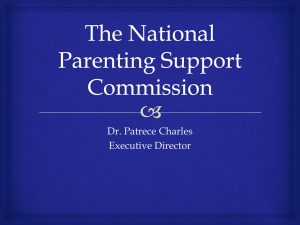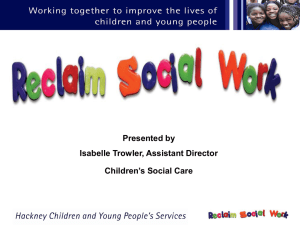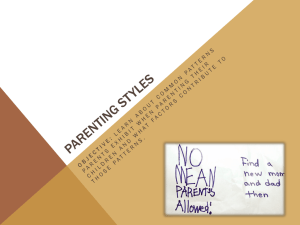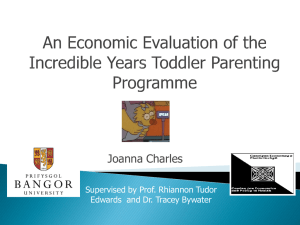Session B - The Hospital for Sick Children
advertisement
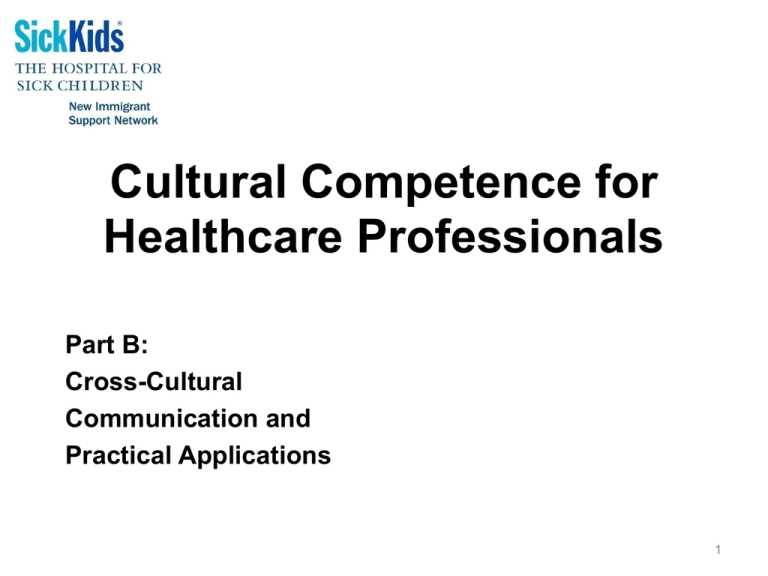
1 Cultural Competence for Healthcare Professionals Part B: Cross-Cultural Communication and Practical Applications 1 Workshops Session A Introduces health disparities, the immigrant experience, social determinants of health (SDOH), and clinical cultural competence. Session B Develops knowledge and skills on collaborative communication, cross-cultural communication, and clinical cultural competence as it pertains to parenting, mental health and pain management. Session C Develops knowledge and skills on clinical cultural competence in the use of complementary and alternative therapies, bereavement and grief. Participants will have an opportunity to practice with Standardized Patients 2 3 Learning Objectives Upon completion of Workshop B participants will be able to: Apply collaborative conversation techniques in a clinical scenario Describe strategies and resources to facilitate cross-cultural communication Recognize cultural differences in parenting practices, mental health perspectives, and the expression of pain Describe strategies for providing culturally competent care to children experiencing pain and mental health problems 3 4 Caveat “The encounter with persons, one by one, rather than categories and generalities, is still the best way to cross lines of strangeness” (Bateson, 2000) 4 Cross-Cultural Communication 5 6 Assigning Meaning Discuss at your tables: What it means to me What it might mean to another Not making eye contact Often saying “YES” Spending time on small talk Arriving late for an appt./class/work Needing to consult family 6 Joy Luck Club 7 Joy Luck Club, (1993) 7 Discussion What did you notice about the ways in which the individuals in the film were communicating? How did culture influence their interactions? 8 9 Context of Communication High Context Communication is less explicit; most of the message is in the physical context or internalized in the person More emphasis on what is left unspoken; more likely to “read into” the interactions i.e. Asian and Latin American cultures Low Context Most of the information is made verbally explicit Information is often repeated to ensure understanding (if it is relevant and important it must be stated, if it is not stated it is not relevant) i.e. North American culture (Hall, 1976) 9 10 Context of Communication High Context More responsibility on the listener – to hear, to interpret and then to act More need for silence; longer pauses (to reflect, understand the context and process the message) Low Context The responsibility for communication lies with the speaker; it is better to over communicate and clarify, than to leave things unsaid Silence and pauses often misunderstood as signs of agreement or a lack of interest (Hall, 1976) 10 Collaborative Conversation: A Communication Tool 11 12 Collaborative Conversations 3 Steps 2 Ingredients Key phrases Empathy Understanding Two concerns I’ve noticed . . . Help me understand . . Tell me more . . Can you explain that a bit more? What else are you thinking? What I’m thinking . . . I’m concerned that . . . I’ve been considering . . Define the Problem Invitation to Generate Solutions Win/win solutions Would you be open to . . .. Could we consider . . . . What can we do about this? Let’s consider . . . What about . . . I wonder if there is a way . . . . (Greene & Ablon, 2006) 12 13 Things to Consider Power Dynamics Experience and Expertise Communication Styles 13 Case Study 14 15 Health Literacy 15 16 What is Health Literacy? Health literacy involves the ability to obtain, process and understand basic health information (Ratzan & Parker, 2000) Canadians with the lowest literacy scores are two and a half times as likely to see themselves as being in fair or poor health (Rootman & Gordon-ElBihbety, 2008) 16 17 Health Literacy We should not assume people understand words or their meaning. Health literacy is more than: giving a family a pamphlet in their own language (English or otherwise) providing interpretation in the language of their choice 17 Interpreter Services and Language Line 18 19 Costs of Not Providing Interpretation in Healthcare A literature review described inequitable care with regard to three specific factors: Inappropriate tests and procedures Increased adverse events Lack of or inappropriate hospital utilization (Access Alliance, 2009) 19 20 Things to Consider… Availability of interpreters Interpreters are sometimes unavailable Strategies are always needed to support effective communication, even when interpreters are unavailable (ex. Language Line) Trained versus untrained interpreters Trained interpreters were 70% less likely to make medical translation errors than untrained interpreters (Gany et al., 2010) 20 21 How to Assess a Family’s Need for an Interpreter Ask the family what language they speak at home Observe what language the family speaks among themselves Explore with the family when having an interpreter may be helpful 21 22 How to Assess a Family’s Need for an Interpreter Pay attention to non-verbal cues Ask the family to tell you their understanding of what was discussed Continue to assess the need for an interpreter on an ongoing basis 22 23 Things to Consider… Barriers to the use of Interpreter Services: Some families may be concerned about confidentiality if they are from a small ethnic community where they may be known to the interpreter Families may decline interpreter services out of fear of being viewed as different or difficult (Chalmers & Rocco-Buckton, 2008) 23 24 Working Effectively with Medical Interpreters Introduce yourself, the interpreter, and the parent and/or patient Briefly provide background information to the interpreter (purpose of the meeting) Address the patient/family, not the interpreter Ensure closure and debrief with the interpreter Document the conversation 24 25 Interpreter Services: SickKids Policy Must be related to direct patient care The request must be made by a healthcare professional 24-48 hours notice must be provided (during business hours) 25 26 Working Effectively with Medical Interpreters 26 27 Language Line: SickKids Policy Recommendations for use of Language Line: – Urgent or same day requests – Ideally, use a phone with a speaker or 3-way calling – Provides services in languages unavailable through Interpreter Services Requires the department cost centre code Available 24/7 27 Cultural Differences in Parenting 28 29 Cross-Cultural Parenting They openly laughed at me for speaking of “teaching” children to walk. A child walks of its accord, they said. I would be saying next that trees had to be instructed in how to bear fruit. (Hogbin, 1943) 29 30 Have you been surprised by a cultural difference in parenting? “Parental behaviours outside of one’s own cultural framework can seem strange or even dangerous” (Greenfield & Suzuki, 1998) 30 31 How Culture Affects Parenting Sleep Feeding Discipline Parenting style Routines Media Play Talking to children Attachment Education Conflicts Safety Family type Adolescence Roles Advice seeking 31 32 Parenting Differences Across Cultures Gusii mothers of Kenya hold their 9-10 month old infants and engage in soothing physical contact more than middle class mothers from Boston, but also look and talk to them less (Richman, Millar & Solomon, 1988) 32 33 Historical Perspective Parent-child relationships among racialized groups are often portrayed as deficient (Keller, Volker & Yovsi, 2005) 33 Individualism and Collectivism in Parenting 34 35 Definitions Individualism Focus on the “I” Goal of autonomy Values – Personal choice Emphasize – Goals focus on the individual preferences, rights and pleasure Universalistic approach – Same values are applied to all Collectivism Focus on the “We” Promote relatedness and interdependence Values – Connection to the family – Respect and obedience Emphasize – Goals focus on the group Pluralistic approach – Different values and standards are applied to members of “in group” and “out group” (Tamis-LeMonda, Way & Hughes, 35 2008, Srivastiva, 2007) 36 Communication Individualism Communicate about the physical world, such as using objects, and other topics that prepare children for school Emphasize outward expressions using words or gestures – e.g. pointing to an object while saying the name to teach infants new words Collectivism Use communication to develop children’s social knowledge, such as how objects relate to one another Use more non-verbal and subtle expression – such as learning games through observation or using touch, gaze, posture, and facial expressions to express meaning (Srivastiva, 2007) 36 37 Family Structure and Roles Individualism The core family unit is usually the authority when it comes to decisions, parenting and child rearing Collectivism The extended family unit plays a key role in child rearing The family system is the highest authority (Srivastiva, 2007) 37 38 Sleep Individualism Often believe that separate sleeping arrangements help children develop independence and maintain parental privacy Collectivism Regularly co-sleep (as many as 2/3 of the world’s cultures) Self-soothing less important Help child-parent bond 38 39 Discipline Individualism Value providing structured discipline while being available, involved, warm and sensitive Encourage thinking about their behaviour and learning about limits Collectivism May use strategies such as shaming Encourage respect for elders and authority figures May use other relatives or networks for discipline 39 (Srivastiva, 2007) 40 Immigrant Parenting Experience Other considerations: Transitioning – Idea of transitioning from child to adult services is based on Western values – The concept of encouraging a child to gain autonomy and make decisions independently may not be appropriate in some cultures Primary caregiver roles 40 (Chalmers & Rocco-Buckton, 2008) 41 Immigrant Parenting Experience PARENTING VIDEO 41 Foreign Visitor Activity 42 43 Foreign Visitor Activity What is the issue? Is the criticism true? Fair? What underlies it? What is the logic behind it? How could you explain or defend it? 43 44 Parenting: Key Considerations Recognize how culture and the new immigrant experience impacts parenting Recognize cross-cultural implications for the teaching that we do around parenting Be aware of the strengths of individualistic and collectivistic approaches to parenting Understand that personal parenting styles may not effectively cross cultures in the context of growth and development 44 45 When teaching about parenting it is important to remember that optimal child development can follow many paths. 45 Mental Health Supporting Immigrant and Refugee Families and their Mental Health Needs 46 47 Culture and Mental Health Culture affects how people: – – – – Label and communicate distress Explain causes of mental health problems Perceive mental health providers Respond to treatment Culture influences who people seek help from and how they access treatment 47 48 New Immigrant Experience and Mental Health Balancing/navigating two or more cultures Intergenerational tension Social determinants of health Language barriers 48 49 Immigration and Mental Health Even though it is a stressful process, immigration itself doesn’t jeopardize mental health. Rather, it is the circumstances that surround the migration including stressful pre and post-migration experiences that determine the risk of developing a mental health problem. (Hyman, 2001) 49 50 Immigrant Youth, Identity, and Mental Health Immigrant children may experience cultural conflict as they attempt to identify with new cultures Biculturalism: “the ability of a person to function effectively in more than one culture and also to switch roles back and forth as the situation changes” (Jambunathan, Burts, & Pierce, 2000) 50 51 Determinants of New Immigrant Mental Health Migration stress (before, during, after) Personal resources Socio-demographic characteristics Social resources 51 52 A Refugee Experience “God Grew Tired of Us”, (2006) 52 53 Refugees and Immigrants: Mental Health Challenges May be separated from family for lengthy periods Moving from rural to urban settings or to entirely different geographical locations Witness to wartime atrocities, refugee camp life, personal or family violence leading to Post-Traumatic Stress Disorder (PTSD) Minority status and/or limited English proficiency 53 54 Mental Health: Key Considerations Culture of origin – is it collectivistic or individualistic? What are the differences in the way mental health is viewed, responded to in collectivistic vs. individualistic cultures? Consider the impact of stigma in relation to mental health 54 55 Support for Immigrant Mental Health in Toronto Access Alliance Four Villages Hong Fook Mental Health Association Mt. Sinai Hospital Across Boundaries 55 56 Pain 56 57 Culture and Pain Management 59 – 74% of African-Americans and Hispanics received inadequate analgesic prescriptions in an outpatient setting (Cleeland, Gonin, Baez, Loehrer, & Pandya, 1997) Study of Mexican-American patients found patients rated their pain higher than nurses rated the patient’s pain (Calvillo & Flaskerud, 1993) Cancer patients belonging to minority groups are at a greater risk for inadequate pain management than nonminority groups (Bernabei et al., 1998; Cleeland, Gonin, Baez, Loehrer, & Pandya, 1997, as cited in Lasch, 2000) 57 58 Culture and Pain Management Latino children received 30% less opioids than Caucasian children for peri-operative analgesia (Jimenez et al., 2010) A Canadian study suggests that differences in pain response in relation to culture may exist for infants as early as 2 months of age (Rosmus, Johnston, Chan-Yip, & Yang, 2000) Studies report varying pain thresholds among different cultural groups (Sawhney, 2007) 58 59 Pain: Cultural Considerations Perception of Pain Treatments Culture Health Beliefs Coping Strategies 59 60 Cultural Experience of Pain From The Spirit Catches You and You Fall Down “I have a particular series of diagnostic questions I usually ask when a person complains of pain,’ said Dave Schneider. ‘I ask what makes it better and what makes it worse? Is it sharp? Dull? Piercing? Tearing? Stinging? Aching? Does it radiate from one place to another? Can you rate its severity on a scale from one to ten? Is it sudden? Is it intermittent? When did it start? How long does it last? I would try to get an interpreter to ask a Hmong these questions, and the interpreter would shrug and say, ‘He just says it hurts.” (Fadiman,1998) 60 61 Cultural Responses to Pain Stoic Patients Less expressive of their pain Tend to “grin and bear it” Tend to withdraw socially Lack of facial grimace does NOT mean that there is no pain Expressive Patients More likely to verbalize their expressions of pain They desire people around them to react to their pain and assist them with their suffering Hispanic, Middle Eastern, and Mediterranean cultures Northern European, North American, Asian cultures (Llewellyn, n.d.) 61 Case Study 62 63 Reflection… What might be a response to the question: “Why do you have pain?” 63 64 Possible Child/Family Expectations May be varied amongst different families The nurse will know that I have pain and bring my medication so I don’t have to ask I don’t talk about pain I know I will have pain but it is just part of the process I do not believe in pain medication I should apologize when I ask for pain medication 64 65 Pain Assessment and Management: Key Considerations Utilize established assessment tools to assist in measuring pain Appreciate variations in affective responses to pain Be sensitive to variations in communication styles Recognize communication of pain may not be acceptable within a culture 65 66 Pain Assessment and Management: Key Considerations Appreciate that the meaning of pain varies between cultures Utilize knowledge of biological variations (vitals) in the assessment and management of pain Develop knowledge of cultural values and beliefs that may affect responses to pain Incorporate culturally specific practices (e.g. CAM therapies) desired by the patient into the pain management plan 66 67 Take Away Activity Option 1: Use a communication resource (Language Line or Interpreter Services) to communicate with a non-English speaking parent Option 2: Utilize collaborative conversation communication tool with a family Option 3: Initiate a discussion about how parenting, pain or mental health differs across cultures 67 Questions? 68 References • • • • • • • Abbe, M., Simon, C., Angiolillo, A., Ruccione, K., & Kodish, E. (2006). A survey of language barriers from the perspective of pediatric oncologists, interpreters and parents. Pediatric Blood Cancer, 47(6), 819-824. Access Alliance Multicultural Community Health Centre. (2009). Literature review: Cost of not providing interpretation in health care. Toronto, Ontario: Author. Bateson, M. C. (2000). Full circles, overlapping lives: Culture and generation in transition. New York: Random House. Bernabei. R, Gambassi. G, Lapane. K, et al. (1998). Management of pain in elderly patients with cancer. Journal of American Medical Association, 79(23):1877-1882. Calvillo, E. R. & Flaskerud, J. H. (1993). Evaluation of the pain response by Mexican American and Anglo American Women and their nurses. Journal of Advanced Nursing, 18(3), 451459. Canadian Public Health Association. (2010). What is Health Literacy. Retrieved May 21, 2010 from http://www.cpha.ca/en/portals/h-l.aspx Chalmers, S. & Rosso-Buckton, A. (2008). Are you taking to me? Negotiating the Challenge of Cultural Diversity in Children’s Health Care. Centre for Cultural Research, University of West Sydney., Australia. 69 References • • • • • • • • Cleeland, C. S., Gonin, R., Baez, L., Loehrer, P., & Pandya, K. J. (1997). Pain and treatment of pain in minority patients with cancer. Annals of Internal Medicine, 127 (9), 813-816. Fadiman, A. (1998). The spirit catches you and you fall down. New York: Farrar, Straus, and Giroux. Gany, F.M., Gonzalez, C. J., Basu, G., Hasan, A., Mukherjee, D., Datta, M., & Changrani, J. (2010). Reducing clinical errors in cancer education: Interpreter training. Journal of Cancer Education 25,560-564. Greene, R. & Ablon, S. J. (2006). Treating explosive kids: The collaborative problem solving approach. New York, New York: The Guildford Press. Greenfield, P. (1994). Independence and interdependence as developmental scripts: Implications for theory, research, and practice. In P. Greenfield & R. Cocking (Eds.), Cross-cultural roots of minority child development (pp.1-37). Mahwah, NJ: Lawrence Erlbaum. Greenfield, P. M., & Suzuki, L. (1998). Culture and human development: Implications for parenting, education, pediatrics and mental health. In I.E. Siegel & K.A. Renninger, (Eds). Handbook of child psychology (Vol. 4, PP. 1059-1109). New York: Wiley. Hall, E. T. (1976). Beyond Culture. New York: Doubleday Hogbin, H.I. (1943). A New Guinea infancy. From conception to weaning in Wogeo. Oceania,13 (4), 285-309. 70 References • • • • • • • • Hospital for Sick Children. (2003). Policies and Procedures: Interpreter Services. Toronto, Ontario: Author. Hyman, I. (2001). Immigration and Health. Health Policy Working Paper Series. Working Paper 0105. Ottawa: Health Canada. Retrieved May 18, 2010 from http://www.hcsc.gc.ca/iacbdgiac/arad-drae/english/rmdd/wpapers/wapapers1.html Jambunathan, S., Burts, D., & Pierce, S. (2000). Comparisons of parenting attitudes among five ethnic groups in the United States. Journal of Comparative Family Studies, 31(4), 395- 406. Jimenez, N. Seidel, K., Martin, L., Rivara, F., & Lynn, A. (2010). Perioperative analgesic treatment in Latino and non-Latino pediatric patients. Journal of Health Care for the poor and underserved, 21(1), 229-236. Keller, H, Völker, S & Yovsi, R-D (2005). Conceptions of parenting in different cultural communities. The case of West African Nso and Northern German women. Social Development, 14(1), 158-180. Lasch, K. (2000). Culture, pain, and culturally sensitive pain care. Pain Management Nursing, 1(3)(Suppl. 1), 16-22. Lie, D., Bereknyei, S., Braddock, C., Encinas, J., Ahearn, S., & Boker, J. R. (2009). Assessing medical students skills in working with interpreters during patient encounters: A validation study of the interpreter scale. Academic Medicine, 84(5), 643-650. Marshall, G (1998) “Assimilation." A Dictionary of Sociology. Retrieved September 24, 2010 from Encyclopedia.com. 71 References • • • • • Ratzan S.C, & Parker R.M. (2000). Introduction. In: National Library of Medicine Current Bibliographies in Medicine: Health Literacy. Selden CR, Zorn M, Ratzan SC, Parker RM, (Eds.) NLM Pub. No. CBM 2000-1. Bethesda, MD: National Institutes of Health, U.S. Department of Health and Human Services. – Need page number Richman, A. L., Miller, P. M. & Solomon, M. J. (1988). In R. A. LeVine, P. M. Miller and M. M West (Eds.), Parental Behavior in Diverse Societies. New Directions in Child Development, No. 40 (pp. 65-74). San Francisco: Jossey-Bass. Rootman, I., & Gordon-El-Bihbety, D. (2008). A vision for a health literate Canada: Report of the expert panel on health literacy. Ottawa, Canada: Canadian Public Health Association. Retrieved May 21, 2010 from http://www.cpha.ca/uploads/portals/hl/report_e.pdf Rosmus, C., Johnston, C. C., Chan-Yip, A., & Yang, F. (2000). Pain response in Chinese and nonChinese Canadian infants: Is there a differences. Social Science and Medicine, 51(2), 175-184. Ross-Sheriff, F. & Husain, A. (2004) South Asian Muslim children and families. In R. Fong. (Ed.), Culturally competent practice with immigrant and refugee children and families (pp. 163- 182). New York: Guilford. 72 References • • • • • Shawny, M. (2007). Pain Management. In Rani Srivastava (Ed.). The healthcare professional guide to clinical cultural competence. Toronto, Ontario: Elsevier Canada. Simon, C., Zyzanski, S. J., Eder, M., Raiz, P., Kodish, E. D., & Siminoff, L. A. (2003). Groups potentially at risk for making poorly informed decisions about entry into clinical trials for childhood cancer. Journal of Clinical Oncology, 21(11), 2173-2178. Srivastava, R. (2007). The healthcare professionals guide to clinical cultural competence. Toronto, Ontario: Elsevier Canada. Tamis-LeMonda, C. S., Way, N., Hughes, D., Yoshikawa, H., Kalman, R. K., & Niwa, E. Y. (2008). Parents‘ goals for children: The dynamic coexistence of individualism and collectivism in cultures and individuals. Social Development, 17, 183-209. T.V. Ontario (n.d). Parenting across cultures: The different ways we raise our children. http://www.youtube.com/user/tvoparents#p/u/98/BJic9NrYk0Y 73





